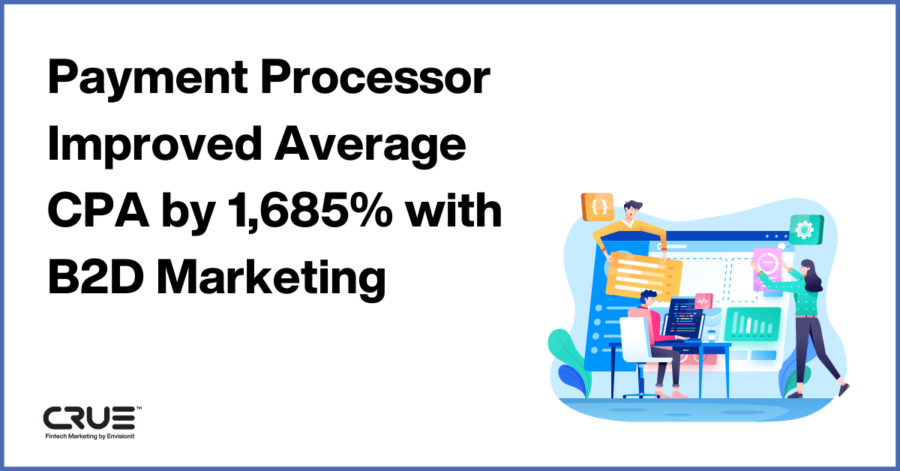Upgrade your fintech digital marketing with these fundamental success strategies
Fintech marketing leaders know that it takes more than tips & tactics to impact your company’s bottomline. Yes, you need an in-house and/or agency team who knows their channels inside and out. But if you’re the one running the ecosystem, you need more macro-level insights to create a strong case for your 2023 fintech marketing strategy.
That’s why our crew of leaders built the Upgrade Your Fintech Digital Marketing playbook. From team design and planning, to decision science and creative strategy, this system will upgrade your annual plan, while impressing your CEO.
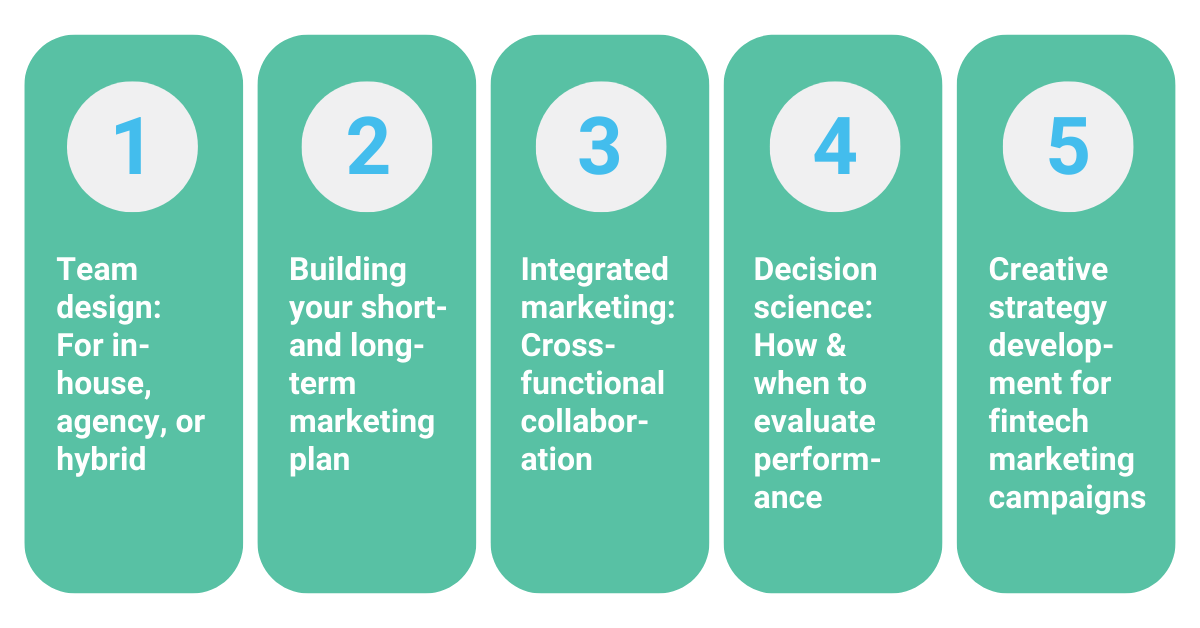
Assembling Your Fintech Marketing Team
How to get the right minds in the right seats
Marketing leaders at fintech companies are very often required to be CTOs, CMOs, CCOs, and more. But, it’s impossible (and exhausting) to be great at all of those things all the time. Over the years, we’ve witnessed firsthand what it takes to successfully deliver on your performance marketing strategy, and it starts with having the right peeps in the right seats, and the right minds around the table. Dig into this team topic specifically in our post: The Ultimate Guide to Designing Your Fintech Marketing Team Structure.
Going agency?
If you’ve partnered with a digital agency (we knew you were smart), make sure the following is true about them, and what they’re bringing to the table:
They’re will to challenge your assumptions
If you’re going to RFP agencies, pick one who’s brave enough to tell you that you’re asking the wrong questions or you aren’t seeing the bigger picture. This isn’t an indication of ego or a slick sales strategy. It means they’re going to look out for your wallet, your professional brand, your company, and your team like they are their own.
Choose the agency that introduces you to the people who will work on your business, not just the leaders of each department. Also, if you already have an agency that isn’t telling you what you should be doing before you have to tell them, it might be time to say, “Thank you, next.” They’re either keeping you ahead or they’re causing you to fall behind.
They’re experts at strategic planning
Your agency should understand the parts and the whole so the “how we’ll get there” doesn’t rest solely on your shoulders. Planning your GTM strategy is just as much an art as it is science. You should leverage the skillsets of those who have been there and bought the t-shirt.
They’re willing to dig in and truly understand your unique value proposition (even if you haven’t quite figured that out yet)
That means not only understanding your product or solution, but also how you sell it. Additionally, evaluate them based on questions like:
- Do they understand your team and their accountabilities?
- Do they know your internal processes and how things get done?
- Do they know who your key stakeholders are and what you’re on the line for?
These qualities make the difference between a true partner and just another vendor.
They’re transparent about performance and they shoot straight
This seems like a given, until you speak with an agency who is trying to convince you that your performance is solid without giving a single explanation of how said performance is in service of your actual goals. Truth hurts, but not everything you try is going to work.
Sometimes the most impactful change comes from understanding what doesn’t work and why. Any agency partner worth their retainer will not only welcome those conversations, but will also be engaged by them.
Your Client Services lead can finish your sentences for you
Often an underrated part of the agency team equation, your relationship with your agency lead can make or break your partnership. They’re a coach, quarterback, cheerleader, (and sometimes therapist) all in one. So don’t be sold on one person’s media genius or the flashiest creative, because at the end of the day, it actually has to work for you. The right account team makes it happen.
They’re in it to win it, and that goes far beyond the their paycheck
In fact, we’d argue that you should consider your agency as one of your greatest assets. To do that, they must be equally committed to celebrating the wins with you as much as they are solving the inevitable challenges that will come up during your engagement (and solving them quickly).
Going in-house?
If you’re handling performance marketing with an in-house team, ensure the following is true:
Your team truly digs your company’s offering, and they’re energized by your mission
It seems obvious, but if this is just a job to them, or you’re simply trying to find more “hands on keyboards” as you’re navigating today’s challenging recruiting climate, you’re setting yourself up for tough decisions–and discussions–down the road.
- First, get your priority roles filled with the right talent, particularly mid-to-senior leaders who will work across creative, media, and technology where the margin for a mis-hire should be low.
- Then, identify the roles where you’re able to lean on tactical versus strategic acumen to simply get the job done, and done correctly. Yes, previous industry experience is a definite plus in fintech.
The ability of a team member to truly hit the ground running by having an understanding of the market, competition, and primary KPIs will take some of the weight off your shoulders. This way, you can focus on developing strong internal partnerships and communicating your progress to the ones who hired you.
They know how to work across the aisle to get it done, particularly among Creative, Media, Product Marketing, and Technology
We have yet to see a successful fintech performance marketing team whose internal operating mantra is “stay in your lane.” This means things take 5x longer than they should, learning and pivoting is slow, creativity is stifled, and the work leaves more to be desired. It’s a lot easier to explain performance issues to leadership when it’s related to market conditions versus a dysfunctional team who isn’t energized by collective success.
Strategy is owned and led by an individual with strong integrated marketing chops
…And we recommend that someone is not you. This is your right-hand person. The yin to your yang. They know how to grease the squeaky wheels, and most importantly, everything they think about and do in their role is in service of accomplishing the goals you’ve set for your marketing program.
This person is a formidable brand strategist who has deep experience with GTM strategy development and execution for growth-stage companies and a proven track record. Boasting a keen eye for what will resonate with your targets, this individual will have strong media acumen and demonstrate just as much care for how the leads are handled and nurtured as generating them.
Whether your ultimate goal is installs, transaction volumes, AUM, or something else entirely, there must be careful attention at each stage of the funnel, and this leader must be all over it.
You have confidence in and trust your creative team’s ability to deliver
From campaign concepts and messaging, to media assets and long format copy, the best performance marketing strategy will mean nothing if your creative strategy isn’t aligned with media, stakeholders, and leadership. Don’t worry–we get into this in more detail later in the playbook.
You trust the data you’re receiving from your analysts and data scientists
You know the saying, “garbage in, garbage out?” Well, that’s why we highly recommend investment in talent that is not only good at demystifying the data for you, but also knows what to do when your data plumbing needs fixing. (Or when it needs to be ripped out and replaced entirely.)
Remember, your analysts should have multi-channel digital campaign experience so they can explain to you and your team how your marketing mix is working together, independent of individual channel performance. Lastly, they should have expert-level knowledge of how channels and platforms differ in how they attribute conversion values.
Going hybrid?
We’ve given you some guidance on how to manage a team in-house, but what if you have a hybrid model utilizing both your in-house team and an agency?
In our experience, this model can work extremely well if you carefully consider your swimlanes. Speaking of which, they’re typically categorized by, but not limited to, the following:
- Integrated Marketing Strategy
- Campaign Concepting & Creative Strategy
- Copywriting & Creative Asset Development
- Media Planning
- Media Buying, Execution, & Management
- Account-Based Marketing
- Data Mining/Data Science
- Campaign Analysis & Performance Reporting
- Marketing Automation & Lead Nurturing
There isn’t a “one size fits all” approach to the hybrid model as it really depends on the capabilities of your internal team members, many of whom you may have inherited and bring their own skills.
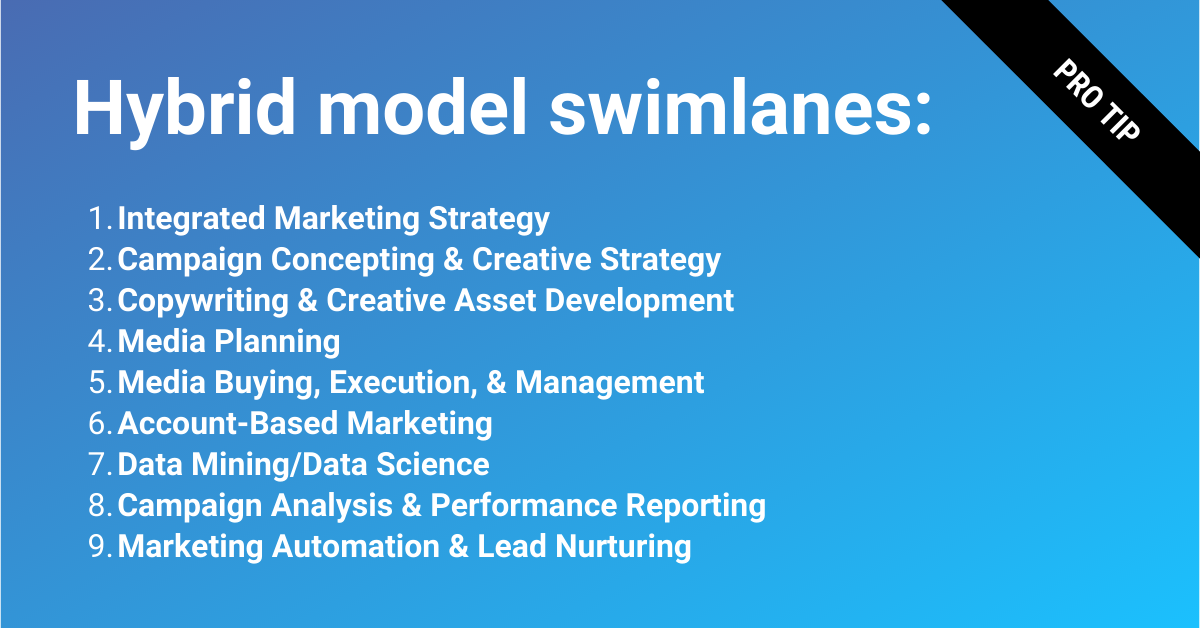
Note: Who will you rely on to stay forward-thinking and mitigate risk?
It’s easy for teams to get lost in the day-to-day management of a marketing program. As a result, important trends and updates that will directly impact your performance can be missed.
- A good example is licensing requirements for fintech advertising. Every platform is different, especially for crypto businesses, and this varies greatly by international market. So you’re not only up against the country’s requirements but the platform’s as well.
- Google, for example, is guided by its own set of policies in the space, and unfortunately they often don’t align with our clients’ needs. This is even the case when a specific country allows crypto-related advertising! It’s important to have a very strong partnership with platform account leads who will actually work with you and/or your fintech media agency to not only understand where you can advertise and where you can’t, but also what messaging is acceptable and what will be flagged.
- This is where having an agency who already has experience navigating these complexities is a real advantage. Additionally, you’ll want to understand a platform’s path to certification in specific markets and the timing of this. Beyond paid search, there are other channels (most notably, programmatic) that operate like the “Wild West” and every DSP is different.
Do you have someone who is familiar with this? Having someone accountable for gathering the information and working with you through your options and requirements is vitally important to the success of your marketing program.
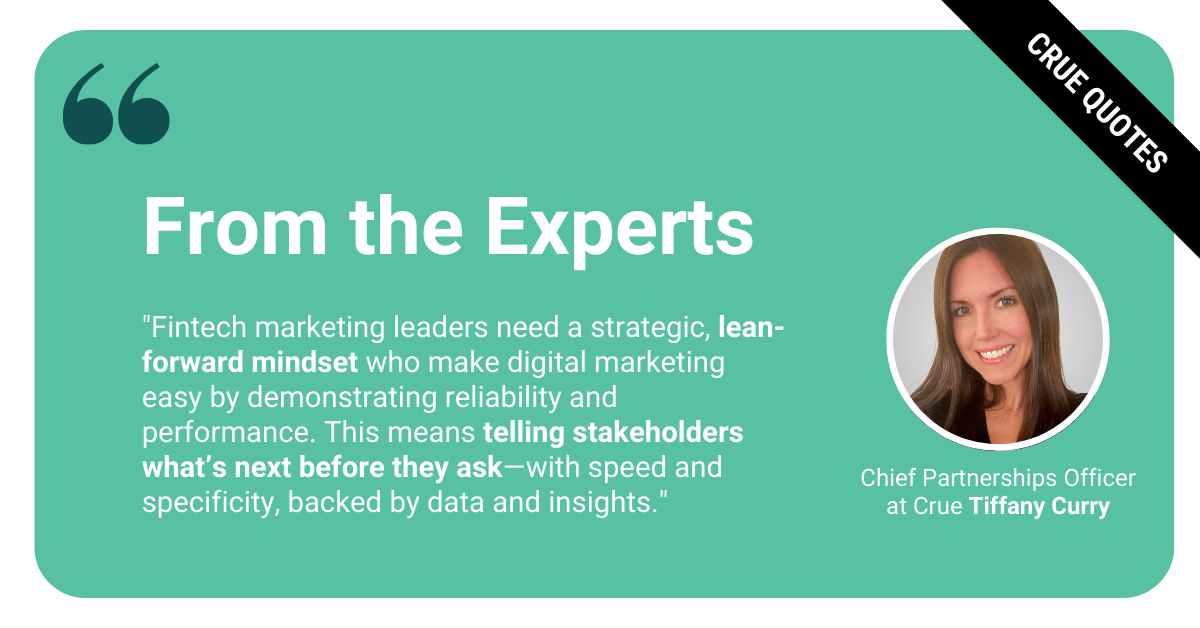
Fintech Marketing Planning
How to Develop Short-term Strategy While Keeping Your Eye on the Bigger Picture
Having a solid goal-oriented plan with built in flexibility is only half the story. How you plan and assess progress is the important part.
At Envisionit, we leverage a VTO (Vision Traction Organizer) methodology that is based on a framework created by Gino Wickman, author of Traction. It started as an internal exercise for our organization to track towards our own annual goals, and then we thought, “Hey, our clients are going through the same exercise. Maybe they could benefit from it too.” So we modified it and made it a part of our own onboarding process with our clients.
Tune into this episode of the Fintech Marketing Strategy Hour podcast to hear CEO & Founder of Envisionit Todd Brook break down the VTO method step-by-step.
At the most basic level, the VTO framework starts with this:
Establish annual objectives and 90-day priorities for your team
Every organization we’ve worked with has had some idea of what needs to be true at the end of a fiscal year. Sometimes, it’s really straightforward, like:
- Deliver 5,000 qualified leads
- Hit 5x for return on marketing spend
- Deliver a cost per acquisition of $100 (this could mean that you have to justify your top-of-funnel marketing efforts by being able to hit that $100 lead)
What you don’t see is, “we’ve positioned ourselves to become a leader in the market.” What does that mean? When you get to the point where you can step back and truly assess your performance, everything you accomplish, or don’t, should be obvious.
If your goals are nebulous to begin with, you’re going to have a hard time trying to understand why you didn’t achieve them and explaining this reality to the powers that be.
Create a VTO
Proper planning should also galvanize your troops. Do they know what is literally required from them to make it happen? Also how do you ensure you’re always tracking towards those milestones and holding them accountable? It starts with the right plan, but it comes to fruition through regular assessment and discussion. Are you on track? Are you off track? If so, why?
At its core, creating your own VTO boils down to the following steps:
- Establish specific annual objectives that are measurable.
- Establish 90-day priorities for your team that specifically ladder up to achieving your objectives—if it’s not measurable and it doesn’t ladder up to your end outcomes for the year, it shouldn’t be on the list. As a general rule, individual team members should not have more than three priorities.
- If you’re working with a hybrid model, also align with your agency partners’ on their 90-day priorities in service of you hitting your annual objectives and document them.
Once you’ve got this in place, how do you create more productive and efficient meetings that keep your team’s eye on the outcomes? It’s all about sticking to the agenda. Even if the team initially finds the structure a little rigid, they’ll eventually get on board when they realize it’s intended to help them be more impactful in their roles. Trust us.
Zero-based budgeting
At Envisionit, we’re strong believers in zero-based budgeting for building your marketing budget. This includes both how to lead an organization, and also how to plan for media and performance marketing investments.
Zero-based budgeting effectively starts from zero. It involves analysis of each granular need of the company versus the incremental budgeting increases associated with traditional budgeting. Essentially, this allows for a strategic, top-down approach to analyze the performance of a given program or project. No longer will you need to commit to unrealistic and arbitrary budgets to support your needs almost a year in advance.
The process is simple but effective
Once the 90-day daily target is set, you can analyze whether the results are ahead or behind your targets. If spending is tracking ahead or behind targets then Optimize the plan for the quarter ahead
You did the work and now here is where you feel the magic of zero-based budgeting. It forces you to make decisions that will ensure your quarterly outcome is achieved. Learn the key decisions to make in our playbook
The zero-based budgeting system provides proactive opportunities to adapt to the quickly changing landscape and make short-term decisions that improve the odds of achieving long-term goals.
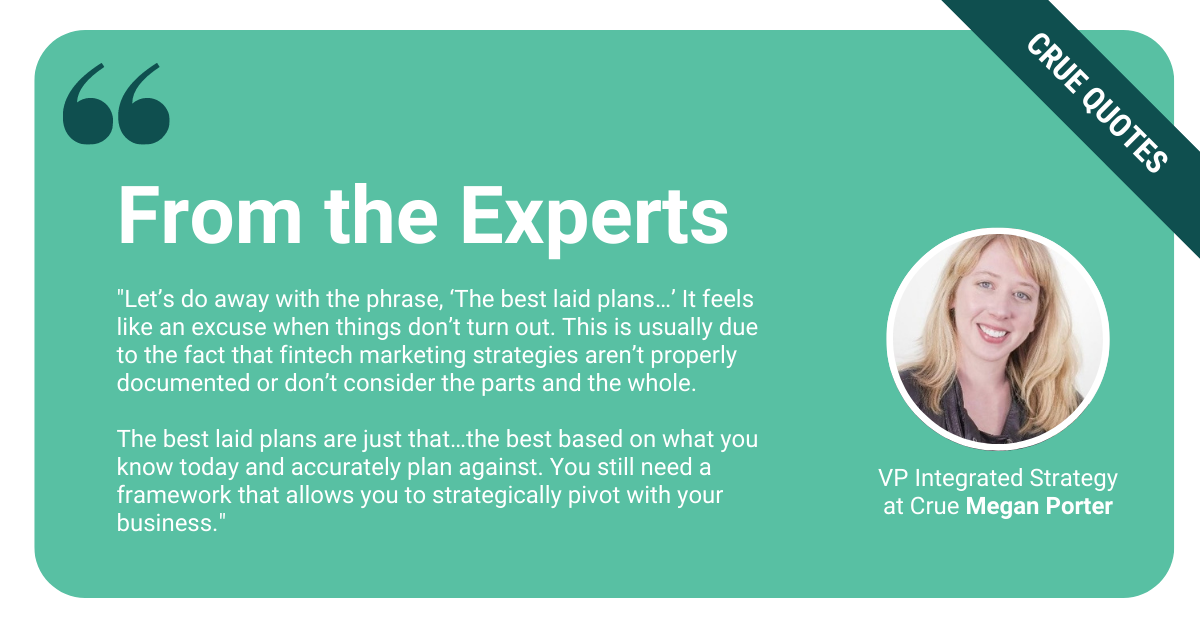
Coordinating Your Talent: Adopting a 1+1=3 Mindset
Brand Marketing, PR and Performance Marketing should all be on each other’s short list of contacts and they should meet monthly.
The idea here is 1+1 = 3. Whether everything you’re doing is in-house or a hybrid, your talent has unique experience that when shared collectively, brings best in class marketing. You want to get more miles out of your budget and efforts, so create the connectivity and be specific about what you expect each group to provide to make your campaigns that much stronger.
Coordination matters
Integrating PR and Media is a successful tactic we use at Envisionit. Here’s how it works:
- Plan and combine efforts on PR across endemic publishers to maximize the release of news with targeted media placements.
- Determine if a specific PR effort is worth paid media support. So often, we’ve seen really engaging news and updates being reported. Get your team connected with the media team to capitalize on every opportunity.
- Share PR plans quarterly and ad hoc to ensure search engine optimization (SEO) is fully considered, like, fully crawlable links and relevant anchor text.
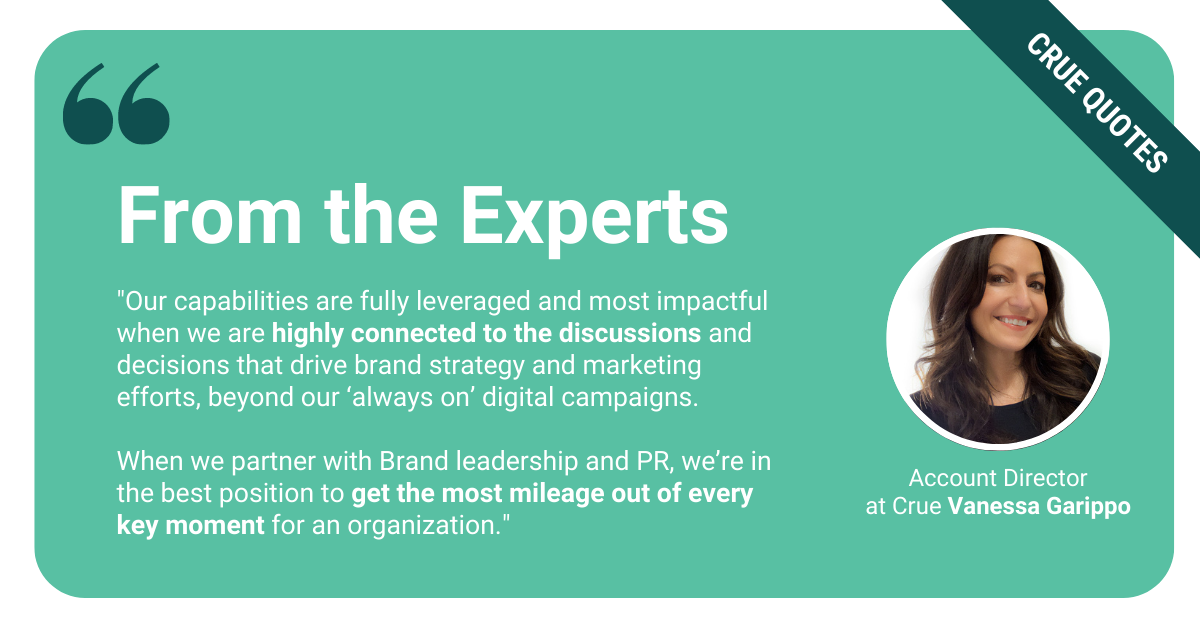
Decision Science
How & When to Evaluate Performance
Tech companies move fast. We’d argue fintech moves even faster. So, it’s easy to get overly prescriptive in the name of speed and maybe even overconfident. We aren’t suggesting you slow down. Instead, we’re going to share insights you may not have considered when it comes to prioritizing and delegating your efforts, allowing you to zero-in on the key metrics.
Communication is key
We’ve all done it. We launch. We hover. We ask “how’s it going?” at 5 a.m. the day after launch. Marketing is full of overachieving professionals that wake up every day thinking about what’s next and how they’re going to beat the world. And when it comes to your organization’s investment in performance marketing, you’re right to be diligent stewards of those dollars.
You should expect your internal media team or agency partner to proactively communicate campaign performance. If you’ve got the right team members in place, they’re going to tell you when you should reach the point of concern if they have enough data to assess and prescribe with confidence.
Before you get started, ensure the following is in place:
- The goal of a specific campaign relates to your overall marketing objective
- Developing a pro forma at the start of every campaign
- Don’t judge a channel by “last click” performance alone but look at bottom-funnel efficiency
- Avoid prioritizing the “rearview mirror” approach to evaluating campaign performance
It’s all in the data
Focus on the right data for the right stakeholders and leverage data visualization and automation.
Make decisioning easy with the right martech, whether it’s your own or a partner’s. Data is the lifeblood of performance insights. Bad data means bad choices. So What’s the secret to being thoughtfully fast when it comes to decisioning?
We have two tips to help you:
1. Develop automated reporting with just the right amount of information
Other stakeholders need access to performance reporting and may not always have the benefit of sitting in on your recurring meetings to go through the data live. So, sometimes a reporting dashboard or deck is the answer.
To ensure what you deliver doesn’t take focus away from your path forward, work with the data science team to customize your performance dashboards based on what you need. Leverage reporting platforms to automate reporting so it’s easy to pull what’s needed for scheduled reporting meetings with your executive leadership team, or facilitate on-demand reporting.
This way, everyone gets what they need and your team members aren’t wasting valuable time repurposing old reports every time there is a request. A win-win for everyone.
2. Make weekly performance reporting more real-time and collaborative
This doesn’t mean that your team comes to meetings unprepared and simply “wings it.” On the contrary, if you have the right data visualization and automation in place, your team is well prepared and can come to the table with actionable insights. There’s nothing worse than coming to pulsing meetings and getting a “weather report” that you could’ve easily gotten for yourself by looking at the data. With real-time visualization and the right expectation setting, you can make your weekly pulsing meetings interactive and collaborative.
Pick out the metrics you’ll be evaluating by channel weekly, drill into them and ask the tough questions because everyone should know what you’re going to zero-in on in advance.
Most importantly, make sure the right players are there to get the most out of everyone’s time and ensure everyone is connected not only to what they’re seeing but why they’re seeing it. This includes the right mix of strategy, media, creative, and data analysts.
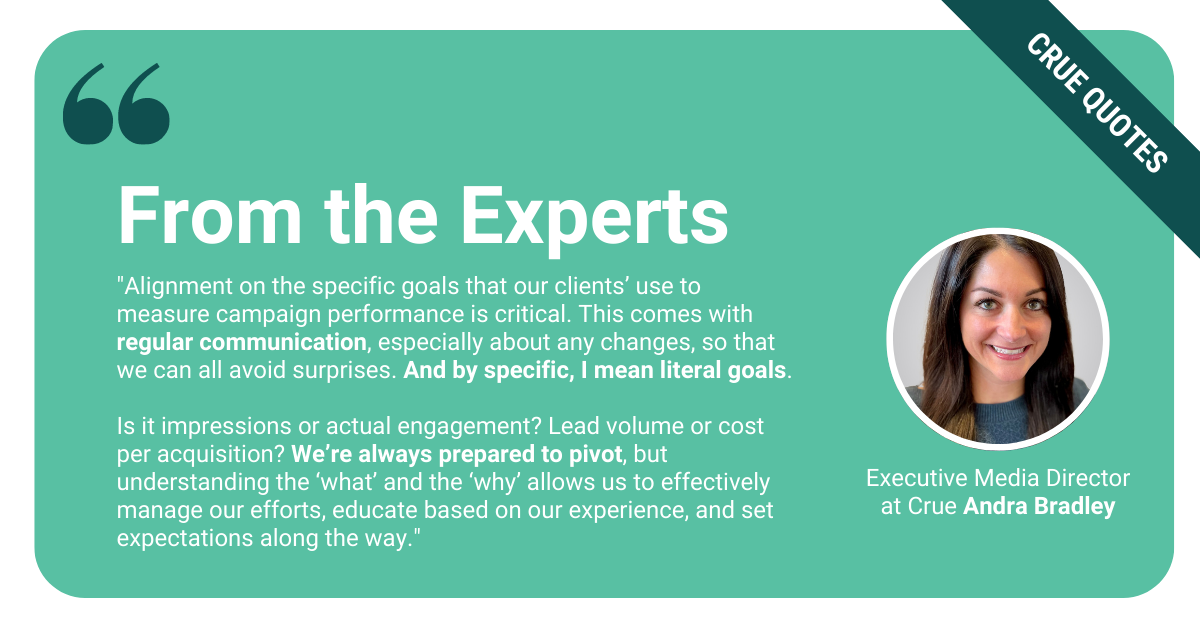
Creative strategy development
Yes, it really is just as important as your media strategy
The best digital marketing strategy in the world means nothing if its creative counterpart is not equally as strong. Once the media placements are in the wild, you’ve made your first impression and over the life of the campaign, they’re either going to recall your message, engage with it, or move on. It’s the most conspicuous part of your campaign.
In-housing your fintech creative team? Five common pitfalls to avoid
We understand the motivation to bring, or keep, creative strategy in-house. In our experience, the reason to in-house creative usually stems from one of the following:
- You’re still developing your brand guidelines so bringing in an outside creative partner may be putting the cart before the horse.
- Your platforms and the solutions they facilitate are in a constant state of flux.
- Executive leadership is hands-on in the process or owning it completely.
- You’ve got a dedicated creative team in-house already and you want to avoid redundancy.
- The general sentiment internally is that no one is more capable at developing GTM messaging than an internal team.
Regardless of the decision, it’s yours to make. At Envisionit, we’ve been exposed to a few models that have worked well when all or some creative work is handled in-house. We’ve also been able to assist our clients by isolating the bumps that occur along the way when certain components are overlooked or worked on in a silo. Here are five we feel are worth noting:
1. Not developing a campaign brief
Note, we didn’t call it a creative brief. A campaign brief is the roadmap for your creative strategy and drives the output of all your efforts. Having a brief for your team and partners versus not having one means the difference between success and disappointment. So crafting one is worth the extra time.
In our experience, successful briefs at a minimum always include the following:
- Purpose and ideal outcome of campaign
- Audience personas
- First-and-third-party audience research
- Media plan and budgeting
- Campaign calendar and flighting of assets
- Setting of and aligning on KPIs and testing plans
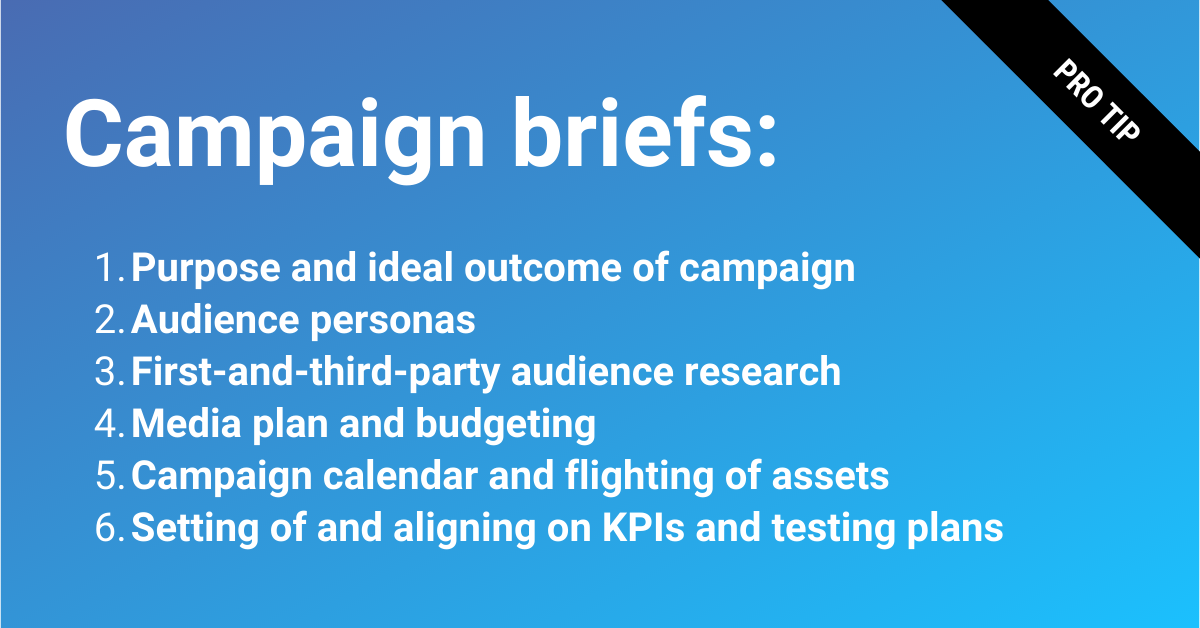
2. Not involving your media partner during campaign brief development
In fact, based on your campaign goals, your media partner should be helping you craft the campaign brief. Allowing them to weigh in early helps avoid defending lackluster performance and allows your media arm to operate in lockstep with you.
3. Not weighing the timing of the campaign against both your and your stakeholders’ expectations
Operating with urgency and operating at breakneck speed are two very different sources of motivation. If you’re looking to execute an impactful campaign with substantial people hours and dollar investment, running at breakneck speed causes chaos.
It can also result in multiple rounds of revisions because you’re not getting the best work out of people, missing assets that weren’t originally considered but are vital to campaign success, and finally creates reason for shortcuts that come back to bite.
4. Not leveraging the data you have available to inform your creative strategy
It’s easy to think you understand the audience enough to put together a creative strategy to support a campaign, especially when you’re doing this in-house and are up against the wire. However, we strongly recommend that you add as much first-party, quantitative and qualitative data to your arsenal in order to provide your in-house creative team and agency partners with the data they need to develop the right message that will be shared at the right time and in the right place.
This can include interviewing or surveying your customers, especially your best ones.
5. Not considering the digital requirements of your creative assets and how they fit into the overall campaign journey
We’ve seen some truly beautiful campaign concepts that come through our inboxes from our clients’ creative teams. Creative we’re excited to get out to our target audiences to see how they’ll react.
However, from a strategic and tactical standpoint, we often see two missing components. They are:
- Messaging that is limited to either the top or the bottom of the funnel.
- Assets that aren’t built exactly to spec for selected ad platforms and need to be modified
Armed with these insights, your creative team and ultimately strategy will be incrementally more successful. We can help you get there, too.
Wrapping Up
So you read this, now what? Well, give these strategies a try. We believe they’ll absolutely help you improve your team building, planning, talent coordination, performance evaluation, and creative strategy.
Overwhelmed with genius and not sure where to start? We got you. You can start by either determining where the weakest link is in your performance marketing plan, or simply follow these guidelines one-by-one until you feel confident in your infrastructure and results.
Either way, you’ve got Envisionit on your side.










